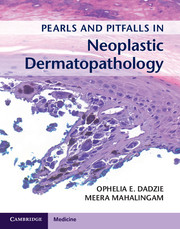Book contents
- Pearls and Pitfalls in Neoplastic Dermatopathology
- Pearls and Pitfalls in Neoplastic Dermatopathology
- Copyright page
- Dedication
- Contents
- Contributors
- Preface
- “It takes a village to raise a child”
- Chapter 1 Introduction
- Chapter 2 Keratinocytic tumors
- Chapter 3 Melanocytic tumors
- Chapter 4 Adnexal tumors
- Chapter 5 Hematolymphoid tumors
- Chapter 6 Fibrous and myofibroblastic tumors and reactive lesions
- Chapter 7 Neural tumors
- Chapter 8 Smooth and striated muscle tumors
- Chapter 9 Vascular and perivascular tumors, and tumor-like conditions
- Chapter 10 Adipocytic tumors
- Chapter 11 Bone and cartilage
- Chapter 12 Uncommon lineage-unrelated tumors
- Chapter 13 Cutaneous metastases
- Chapter 14 Medicolegal pitfalls in dermatopathology: perspectives from the USA and the UK
- Index
- References
Chapter 6 - Fibrous and myofibroblastic tumors and reactive lesions
Published online by Cambridge University Press: 05 July 2016
- Pearls and Pitfalls in Neoplastic Dermatopathology
- Pearls and Pitfalls in Neoplastic Dermatopathology
- Copyright page
- Dedication
- Contents
- Contributors
- Preface
- “It takes a village to raise a child”
- Chapter 1 Introduction
- Chapter 2 Keratinocytic tumors
- Chapter 3 Melanocytic tumors
- Chapter 4 Adnexal tumors
- Chapter 5 Hematolymphoid tumors
- Chapter 6 Fibrous and myofibroblastic tumors and reactive lesions
- Chapter 7 Neural tumors
- Chapter 8 Smooth and striated muscle tumors
- Chapter 9 Vascular and perivascular tumors, and tumor-like conditions
- Chapter 10 Adipocytic tumors
- Chapter 11 Bone and cartilage
- Chapter 12 Uncommon lineage-unrelated tumors
- Chapter 13 Cutaneous metastases
- Chapter 14 Medicolegal pitfalls in dermatopathology: perspectives from the USA and the UK
- Index
- References
- Type
- Chapter
- Information
- Pearls and Pitfalls in Neoplastic Dermatopathology , pp. 250 - 303Publisher: Cambridge University PressPrint publication year: 2000

